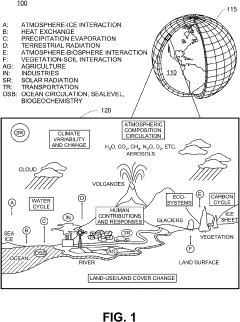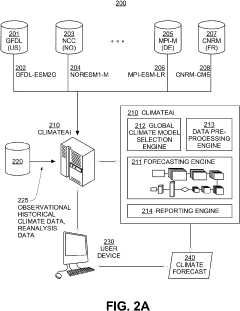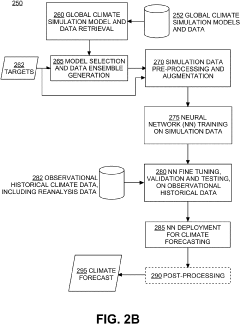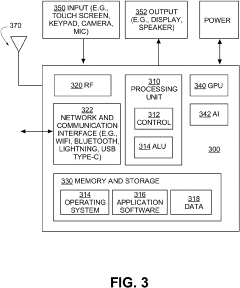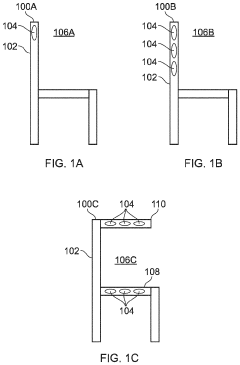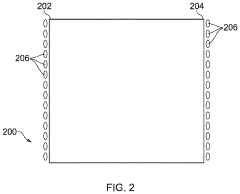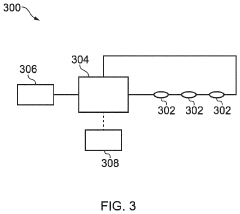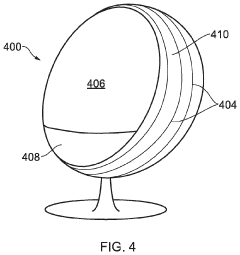Using Schumann Resonance to Study Global Climate Change
Schumann Resonance Background and Objectives
Schumann resonances, discovered by physicist Winfried Otto Schumann in 1952, are global electromagnetic resonances generated and excited by lightning discharges in the cavity formed by the Earth's surface and the ionosphere. These resonances occur at extremely low frequencies (ELF) with fundamental modes around 7.83 Hz and harmonics at approximately 14.3, 20.8, 27.3, and 33.8 Hz.
The study of Schumann resonances has evolved significantly over the past seven decades, from initial theoretical predictions to practical applications in various scientific fields. Initially, these resonances were primarily of interest to atmospheric scientists and geophysicists. However, their potential for studying global climate change has gained increasing attention in recent years.
The connection between Schumann resonances and climate change lies in the sensitivity of these resonances to global temperature variations, atmospheric composition, and ionospheric conditions. As global temperatures rise, the frequency and amplitude of Schumann resonances may be affected due to changes in the Earth-ionosphere cavity's properties and lightning activity patterns.
The primary objective of using Schumann resonances to study global climate change is to develop a novel, non-invasive method for monitoring long-term climate trends on a global scale. This approach offers several advantages over traditional climate monitoring techniques, including continuous global coverage, sensitivity to subtle atmospheric changes, and the ability to provide integrated measurements of various climate-related parameters.
Researchers aim to establish robust correlations between Schumann resonance characteristics and key climate indicators, such as global temperature, atmospheric water vapor content, and the frequency and intensity of extreme weather events. By analyzing long-term trends in Schumann resonance data, scientists hope to gain new insights into the Earth's changing climate system and potentially identify early warning signs of significant climate shifts.
Another important goal is to use Schumann resonances as a complementary tool to existing climate monitoring networks, enhancing our understanding of complex climate processes and improving the accuracy of climate models. This integration of Schumann resonance data with other climate observations could lead to more comprehensive and reliable climate predictions.
As technology advances, there is also a focus on developing more sensitive and precise measurement techniques for Schumann resonances. This includes the design of advanced ELF receivers, improved signal processing algorithms, and the establishment of a global network of monitoring stations to provide continuous, high-quality data for climate research.
Climate Change Monitoring Demand
The demand for accurate and comprehensive climate change monitoring has grown significantly in recent years, driven by the urgent need to understand and mitigate the impacts of global warming. Traditional methods of climate monitoring, such as weather stations and satellite observations, provide valuable data but often lack the global coverage and real-time capabilities required for a holistic understanding of climate dynamics.
In this context, the use of Schumann Resonance (SR) for studying global climate change presents a promising avenue for enhancing our monitoring capabilities. SR, a set of spectral peaks in the Earth's electromagnetic field spectrum, offers a unique global perspective on atmospheric conditions and potentially climate-related phenomena. The growing interest in SR-based climate monitoring stems from its ability to provide continuous, real-time data on a global scale, complementing existing monitoring systems.
The market for climate change monitoring solutions is expanding rapidly, with governments, research institutions, and private sector entities investing heavily in new technologies. According to recent market reports, the global environmental monitoring market, which includes climate change monitoring, is expected to reach substantial growth in the coming years. This growth is fueled by increasing environmental regulations, public awareness of climate issues, and the need for data-driven decision-making in climate policy.
SR-based climate monitoring systems could potentially address several key market demands. Firstly, there is a growing need for real-time, global-scale data to improve climate models and predictions. SR measurements could provide continuous data on global temperature, humidity, and other atmospheric parameters, enhancing the accuracy of climate forecasts and early warning systems for extreme weather events.
Secondly, there is increasing demand for cost-effective monitoring solutions that can cover large geographical areas. SR monitoring stations are relatively inexpensive to set up and maintain compared to extensive networks of weather stations or satellite systems, making them an attractive option for developing countries and remote regions.
Furthermore, the integration of SR data with existing climate monitoring networks could create more comprehensive and robust climate datasets. This integration aligns with the market trend towards big data analytics and AI-driven climate modeling, offering new insights into climate patterns and trends.
The potential applications of SR-based climate monitoring extend beyond scientific research. Industries such as agriculture, energy, and insurance are increasingly seeking detailed climate data to inform their operations and risk assessments. SR monitoring could provide valuable inputs for precision agriculture, renewable energy planning, and climate-related risk modeling.
As awareness of climate change impacts grows, there is also a rising demand for transparent and accessible climate data among the general public and policymakers. SR-based monitoring systems could contribute to public-facing climate dashboards and educational tools, meeting the need for clear, real-time information on global climate conditions.
Current SR Measurement Challenges
The measurement of Schumann Resonances (SR) for studying global climate change faces several significant challenges. One of the primary difficulties is the extremely low frequency and amplitude of SR signals, typically ranging from 7.83 Hz to 45 Hz with amplitudes in the picoTesla range. This requires highly sensitive and specialized equipment to detect and accurately measure these subtle electromagnetic oscillations.
Environmental interference poses another major obstacle. SR measurements are susceptible to various sources of noise, including man-made electromagnetic pollution, geomagnetic disturbances, and local weather conditions. Urban areas, in particular, present a challenging environment due to the prevalence of electrical and electronic devices that can mask or distort SR signals.
The global nature of SR phenomena necessitates a network of monitoring stations distributed across different geographical locations. However, establishing and maintaining such a network is logistically complex and financially demanding. Ensuring consistency in measurement techniques and equipment calibration across diverse sites adds another layer of complexity to the challenge.
Temporal variations in SR signals present yet another hurdle. SR characteristics exhibit diurnal and seasonal fluctuations, as well as longer-term changes potentially linked to climate variations. Distinguishing climate-related changes from natural variability requires long-term, continuous monitoring, which is resource-intensive and technically demanding.
Data analysis and interpretation of SR measurements in the context of climate change is also challenging. The relationship between SR parameters and climate variables is complex and not fully understood. Developing robust models and algorithms to extract meaningful climate-related information from SR data remains an active area of research.
Furthermore, the interdisciplinary nature of using SR for climate studies necessitates collaboration between experts in atmospheric science, geophysics, and electromagnetic theory. Bridging these diverse fields and integrating their insights poses both intellectual and practical challenges.
Technological limitations in sensor technology and data processing capabilities also impact the accuracy and resolution of SR measurements. Advancing these technologies to improve signal detection, noise reduction, and data analysis is crucial for enhancing the utility of SR in climate change research.
Lastly, the need for standardization in SR measurement protocols and data reporting formats presents an ongoing challenge. Establishing universally accepted standards is essential for comparing results across different studies and integrating SR data into broader climate research initiatives.
Existing SR-Climate Change Methods
01 Monitoring and analyzing Schumann resonance for climate change detection
Systems and methods for monitoring and analyzing Schumann resonance frequencies to detect and predict climate change patterns. This approach utilizes the relationship between global electromagnetic resonances and various atmospheric and climatic phenomena to provide insights into climate change dynamics.- Monitoring and analyzing Schumann resonance for climate change detection: Systems and methods for monitoring and analyzing Schumann resonance frequencies to detect and predict climate change patterns. These techniques involve measuring electromagnetic signals in the Earth's atmosphere and correlating them with climate data to identify trends and potential impacts on global weather systems.
- Schumann resonance-based weather modification techniques: Innovative approaches to weather modification using Schumann resonance principles. These methods involve manipulating atmospheric electromagnetic fields to influence local and regional weather patterns, potentially mitigating the effects of climate change.
- Schumann resonance devices for environmental monitoring: Development of specialized devices and sensors designed to measure and analyze Schumann resonance frequencies for environmental monitoring purposes. These tools can provide valuable data on atmospheric conditions and potential climate change indicators.
- Integration of Schumann resonance data in climate models: Methods for incorporating Schumann resonance data into existing climate models to improve their accuracy and predictive capabilities. This integration allows for a more comprehensive understanding of the Earth's electromagnetic environment and its relationship to climate change.
- Schumann resonance-based early warning systems for climate events: Development of early warning systems that utilize Schumann resonance data to predict and alert about impending climate-related events such as severe storms, hurricanes, or other extreme weather phenomena potentially linked to climate change.
02 Schumann resonance-based weather modification techniques
Technologies that leverage Schumann resonance to influence weather patterns and potentially mitigate climate change effects. These methods involve manipulating the Earth's electromagnetic field to induce changes in atmospheric conditions and weather systems.Expand Specific Solutions03 Integration of Schumann resonance data in climate models
Incorporation of Schumann resonance measurements into climate prediction models to enhance their accuracy and predictive capabilities. This approach combines traditional climate data with electromagnetic field observations to create more comprehensive and reliable climate change projections.Expand Specific Solutions04 Schumann resonance-based early warning systems for extreme weather events
Development of early warning systems that utilize Schumann resonance anomalies to predict and alert about impending extreme weather events potentially linked to climate change. These systems aim to improve disaster preparedness and response in the face of increasing climate-related risks.Expand Specific Solutions05 Schumann resonance frequency modulation for climate stabilization
Experimental techniques aimed at modulating Schumann resonance frequencies to potentially stabilize or mitigate climate change effects. These approaches explore the possibility of influencing global climate patterns through controlled alterations of the Earth's electromagnetic environment.Expand Specific Solutions
Key Players in SR Research
The field of using Schumann Resonance to study global climate change is in its early developmental stages, with a growing market as climate research becomes increasingly critical. The technology's maturity is still evolving, with academic institutions like Beijing Normal University, Nanjing Forestry University, and Wuhan University leading research efforts. Companies such as ClimateAI, Inc. and Impact Observatory, Inc. are exploring commercial applications. The involvement of major corporations like IBM and Boeing suggests potential for broader industrial adoption. However, the technology remains largely in the research phase, with ongoing efforts to refine methodologies and improve data interpretation for more accurate climate change assessments.
ClimateAI, Inc.
University of Bern
SR-Climate Change Correlation Studies
- A neural network-based climate forecasting model is developed, trained on pre-processed multi-model ensemble global climate simulation data, using techniques like spatial and temporal homogenization, augmentation with synthetic data, and fine-tuned with observational historical data to enhance forecasting accuracy and efficiency.
- A magnetic field exposure system generating an amplitude-modulated low frequency magnetic field with a carrier frequency of 360 to 450 Hz and a modulation frequency of 0.5 to 100 Hz, providing a field strength of 0.5 to 250 μT, specifically designed to enhance cell survival, proliferation, reduce stress, and promote tissue regeneration.
Data Integration and Modeling
The integration of Schumann Resonance (SR) data with other climate-related datasets is crucial for developing comprehensive models to study global climate change. This process involves combining SR measurements with various atmospheric, oceanic, and terrestrial data sources to create a holistic view of the Earth's climate system.
One of the primary challenges in data integration is the diverse nature of the datasets involved. SR data, typically collected through electromagnetic field sensors, must be harmonized with satellite observations, ground-based weather station records, and other climate-related measurements. This requires sophisticated data preprocessing techniques to ensure compatibility and consistency across different data types and formats.
Advanced statistical methods and machine learning algorithms play a vital role in the data integration process. Techniques such as data fusion, principal component analysis, and neural networks are employed to merge disparate datasets and extract meaningful patterns. These methods help in identifying correlations between SR parameters and other climate indicators, such as temperature, precipitation, and atmospheric composition.
The development of climate models incorporating SR data necessitates a multidisciplinary approach. Atmospheric scientists, geophysicists, and data scientists collaborate to create models that accurately represent the complex interactions between the Earth's electromagnetic environment and climate systems. These models must account for the various factors influencing SR, including solar activity, ionospheric conditions, and global lightning activity.
Temporal and spatial resolution of the integrated data is a critical consideration in model development. SR data, typically collected at specific locations, must be interpolated and extrapolated to provide global coverage. This process involves sophisticated spatial analysis techniques and the use of geostatistical methods to ensure accurate representation of SR variations across different regions and time scales.
The validation of integrated models is an essential step in the research process. This involves comparing model outputs with historical climate data and independent observations to assess the accuracy and reliability of the predictions. Rigorous validation procedures help in refining the models and improving their predictive capabilities for future climate scenarios.
As the field of climate change research evolves, the integration of SR data into climate models continues to advance. Emerging technologies, such as artificial intelligence and quantum computing, offer new possibilities for enhancing data integration and modeling capabilities. These advancements promise to provide more accurate and detailed insights into the complex relationships between SR and global climate change.
Environmental Policy Implications
The integration of Schumann Resonance (SR) research into global climate change studies has significant implications for environmental policy. As this novel approach gains traction in the scientific community, policymakers are presented with new opportunities to refine and enhance climate change mitigation and adaptation strategies.
One of the primary policy implications is the potential for improved early warning systems. SR measurements can provide real-time data on global temperature changes and atmospheric dynamics. This information could be instrumental in developing more responsive and proactive environmental policies, allowing governments to implement timely interventions in the face of rapidly changing climate conditions.
Furthermore, the use of SR in climate change research may lead to more comprehensive and accurate climate models. This enhanced understanding of Earth's climate system could inform the development of more targeted and effective environmental regulations. Policymakers may be able to craft legislation that addresses specific aspects of climate change with greater precision, potentially leading to more efficient use of resources in mitigation efforts.
The global nature of SR measurements also has implications for international environmental policy. As SR provides a holistic view of Earth's climate, it could foster greater cooperation among nations in addressing climate change. This may lead to more cohesive and coordinated global environmental policies, potentially strengthening international agreements such as the Paris Agreement.
Additionally, the incorporation of SR data into climate change assessments could influence carbon pricing policies. More accurate predictions of climate change impacts could lead to adjustments in carbon tax rates or cap-and-trade systems, ensuring that these economic instruments more accurately reflect the true cost of carbon emissions.
The use of SR in climate change research may also impact policies related to renewable energy adoption. As SR measurements provide insights into global temperature trends, they could inform decisions on the most effective locations and types of renewable energy infrastructure to deploy. This could lead to more targeted incentives and subsidies for renewable energy development in areas most vulnerable to climate change impacts.
Lastly, the integration of SR data into climate change studies could influence adaptation policies. By providing a more nuanced understanding of climate change patterns, SR research could help policymakers develop more effective strategies for building resilience in vulnerable communities and ecosystems. This could lead to more targeted allocation of resources for adaptation measures, such as infrastructure improvements or ecosystem restoration projects.
